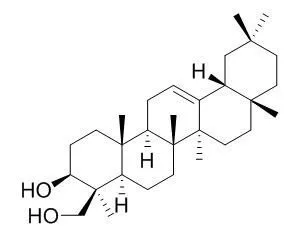| Structure Identification: |
| FEBS Journal,2006,273(5):948-59. | | Identification of β‐amyrin and sophoradiol 24‐hydroxylase by expressed sequence tag mining and functional expression assay.[Reference: WebLink] | Triterpenes exhibit a wide range of structural diversity produced by a sequence of biosynthetic reactions. Cyclization of oxidosqualene is the initial origin of structural diversity of skeletons in their biosynthesis, and subsequent regio- and stereospecific hydroxylation of the triterpene skeleton produces further structural diversity. The enzymes responsible for this hydroxylation were thought to be cytochrome P450-dependent monooxygenase, although their cloning has not been reported.
METHODS AND RESULTS:
To mine these hydroxylases from cytochrome P450 genes, five genes (CYP71D8, CYP82A2, CYP82A3, CYP82A4 and CYP93E1) reported to be elicitor-inducible genes in Glycine max expressed sequence tags (EST), were amplified by PCR, and screened for their ability to hydroxylate triterpenes (beta-amyrin or sophoradiol) by heterologous expression in the yeast Saccharomyces cerevisiae. Among them, CYP93E1 transformant showed hydroxylating activity on both substrates. The products were identified as olean-12-ene-3beta,24-diol(Olean-12-ene-3,24-diol) and soyasapogenol B, respectively, by GC-MS. Co-expression of CYP93E1 and beta-amyrin synthase in S. cerevisiae yielded olean-12-ene-3beta,24-diol. This is the first identification of triterpene hydroxylase cDNA from any plant species.
CONCLUSIONS:
Successful identification of a beta-amyrin and sophoradiol 24-hydroxylase from the inducible family of cytochrome P450 genes suggests that other triterpene hydroxylases belong to this family. In addition, substrate specificity with the obtained P450 hydroxylase indicates the two possible biosynthetic routes from triterpene-monool to triterpene-triol. |
|






 Cell. 2018 Jan 11;172(1-2):249-261.e12. doi: 10.1016/j.cell.2017.12.019.IF=36.216(2019)
Cell. 2018 Jan 11;172(1-2):249-261.e12. doi: 10.1016/j.cell.2017.12.019.IF=36.216(2019) Cell Metab. 2020 Mar 3;31(3):534-548.e5. doi: 10.1016/j.cmet.2020.01.002.IF=22.415(2019)
Cell Metab. 2020 Mar 3;31(3):534-548.e5. doi: 10.1016/j.cmet.2020.01.002.IF=22.415(2019) Mol Cell. 2017 Nov 16;68(4):673-685.e6. doi: 10.1016/j.molcel.2017.10.022.IF=14.548(2019)
Mol Cell. 2017 Nov 16;68(4):673-685.e6. doi: 10.1016/j.molcel.2017.10.022.IF=14.548(2019)